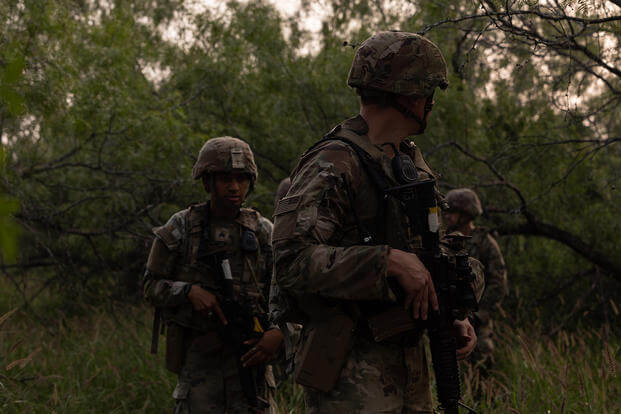Hundreds more miles of federal land along the U.S. southern border in Arizona is set to be transferred to the Department of Defense, further expanding newly created military zones — and the footprint of the military’s role in immigration enforcement.
The newest military zone in Arizona — the fourth border zone created by the Trump administration — will encompass 140 miles of Department of Interior land near the Barry M. Goldwater range and will be transferred to the military as an extension of Marine Corps Air Station Yuma, Pentagon spokesman Sean Parnell told reporters Wednesday.
The administration has created the zones as a way to tap the military to enforce its border security and immigrant deportation agenda, and they allow additional court charges to be filed against those who trespass. Most recently, Defense Secretary Pete Hegseth last month said an additional 250 miles, this time along the Rio Grande River, would be handed to the Department of the Air Force as an extension of Joint Base San Antonio, Military.com previously reported.
Read Next: Army Creating New Artificial Intelligence-Focused Occupational Specialty and Officer Field
Once those two new federal leases are transferred, it will mean that the Army, Air Force and Marine Corps will all have an ownership stake in enforcing security at the U.S. southern border.
Two other military zones have already been created at the border, one in New Mexico that is an extension of the Army’s Fort Huachuca, Arizona, and another in West Texas that is considered a part of Fort Bliss. Last month, U.S. attorneys announced some of the first convictions of migrants who crossed into the zones.
Meanwhile, officials are offering differing numbers on just how many active-duty troops are involved in the expanding border mission.
At the press briefing, Parnell told reporters that about 8,500 military personnel are currently assigned to the active-duty Joint Task Force Southern Border mission. The figure is a drop from earlier figures of around 10,000. One defense official said the new figure doesn’t reflect any units being removed but rather the normal ebb and flow of personnel for a long-standing mission.
Maj. Geoffrey Carmichael, a spokesman for the border mission, told Military.com on Wednesday that the total number of Joint Task Force Southern Border personnel was hovering around 7,600.
Another defense official said the roughly 1,000-person difference between the two figures was because the 7,600 number was troops directly on the border while the larger 8,500 number Parnell offered included various personnel supporting or on loan to the Department of Homeland Security and the border mission.
In total, upward of 600 miles of the U.S. southern border with Mexico has either been placed, or is soon to be placed, under the Department of Defense’s ownership.
Following President Donald Trump’s earliest executive orders this year, the military has expanded its integration with the Department of Homeland Security, Immigration and Customs Enforcement, and Customs and Border Protection, a move that continues to alarm defense and legal experts, Military.com has previously reported.
“It seems to be a growing trend,” Jennifer Kavanagh, the director of military analysis at the Defense Priorities think tank in Washington, D.C., told Military.com on Wednesday. “There are obviously limits to how much of the land along the border they can militarize easily — private land will be more challenging — but I would expect them to keep pushing ahead with this tactic.”
In addition to the thousands of military personnel now patrolling the border alongside the Border Patrol, the Pentagon says that the efforts to build the first ICE detention center on a military installation are making progress.
The first defense official who spoke with Military.com said that the ground at Fort Bliss, located near El Paso, Texas, has already been prepared for a “temporary, soft-sided holding facility” that will be paid for by the Army but run by contractors, not military personnel.
When asked whether there were plans to expand efforts for holding facilities to other bases, the official noted that the Pentagon is “a planning organization” but that they had nothing to announce at the present time.
The result, according to Parnell, is that there have been more than 3,500 patrols, including 150 with the Mexican military, since March 20.
Parnell boasted that between June 28 and June 30 there were zero “get-aways” — people crossing the border who either flee from patrols back into Mexico or into the U.S.
“We have made incredible progress and will continue to work toward achieving 100% operational control of the border,” Parnell told reporters.
However, the claims come as the Pentagon heads into a budget season that leaves a lot of questions about how it will pay for the expanded operations.
Last week, officials said that more than $5 billion is being budgeted in the upcoming year for operations at the U.S. southern border.
But defense officials, who briefed the press on annual budget plans, said they are betting on a Trump agenda bill in Congress to backfill any money pulled from current military funds to help pay for not only the thousands of troops deployed to the U.S.-Mexico border but also those sent to Los Angeles after immigration raid protests in the city.
Meanwhile, the military services have been raiding other parts of their budgets — namely those aimed at upkeeping and building new barracks — to make ends meet.
The Pentagon has already moved to gut $1 billion from the Army’s facilities budget, which the service was planning to use on living quarters for junior troops that have suffered from dilapidated conditions for years.
Related: Guardsmen Pulled off LA Mission as State Warns Troops Are ‘Stretched Thin’ Amid Wildfire Season
Story Continues
Read the full article here

